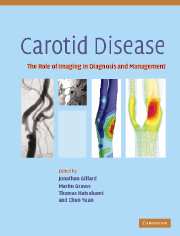Book contents
- Frontmatter
- Contents
- List of contributors
- List of abbreviations
- Introduction
- Background
- Luminal imaging techniques
- Morphological plaque imaging
- Functional plaque imaging
- Plaque modelling
- Monitoring the local and distal effects of carotid interventions
- Monitoring pharmaceutical interventions
- 30 Vascular imaging and the clinical development of new pharmaceuticals
- 31 Monitoring pharmaceutical interventions with conventional ultrasound (IMT)
- 32 Monitoring pharmaceutical interventions with IVUS
- 33 Monitoring of pharmaceutical interventions: MR plaque imaging
- Future directions in carotid plaque imaging
- Index
- References
32 - Monitoring pharmaceutical interventions with IVUS
from Monitoring pharmaceutical interventions
Published online by Cambridge University Press: 03 December 2009
- Frontmatter
- Contents
- List of contributors
- List of abbreviations
- Introduction
- Background
- Luminal imaging techniques
- Morphological plaque imaging
- Functional plaque imaging
- Plaque modelling
- Monitoring the local and distal effects of carotid interventions
- Monitoring pharmaceutical interventions
- 30 Vascular imaging and the clinical development of new pharmaceuticals
- 31 Monitoring pharmaceutical interventions with conventional ultrasound (IMT)
- 32 Monitoring pharmaceutical interventions with IVUS
- 33 Monitoring of pharmaceutical interventions: MR plaque imaging
- Future directions in carotid plaque imaging
- Index
- References
Summary
Introduction
A number of therapeutic strategies have been demonstrated to have a profound impact on coronary artery disease. Accordingly, these agents have become an integral component of cardiovascular prevention regimens. In many cases, however, initiation of therapy after a clinical event is often too late, whether that is myocardial ischemia, transient ischemic attack or more focal infarction. In addition, the majority of clinical events are not prevented by the use of these therapies. As atherosclerotic cardiovascular disease remains the scourge of Western societies and is becoming increasingly prevalent within developing nations, there is an ongoing need to develop interventions that effectively reduce vascular risk.
While the final determinant of proof of efficacy of these agents resides in their ability to prevent clinical events, any assessment of an agent must be performed on the background of a combination of agents with proven efficacy. The background use of multiple efficacious agents has resulted in progressively lower event rates in patients assigned to placebo arms in clinical trials. As a result, an increasingly larger number of patients need to be followed for longer time periods in clinical trials to observe event rates that allow for an evaluation of the efficacy of these agents. As development of experimental agents is a long and costly process, it has become increasingly attractive to assess the effect of agents on a number of surrogate endpoints, in order to provide preliminary information in the design of large-scale clinical event trials.
Keywords
- Type
- Chapter
- Information
- Carotid DiseaseThe Role of Imaging in Diagnosis and Management, pp. 451 - 463Publisher: Cambridge University PressPrint publication year: 2006



